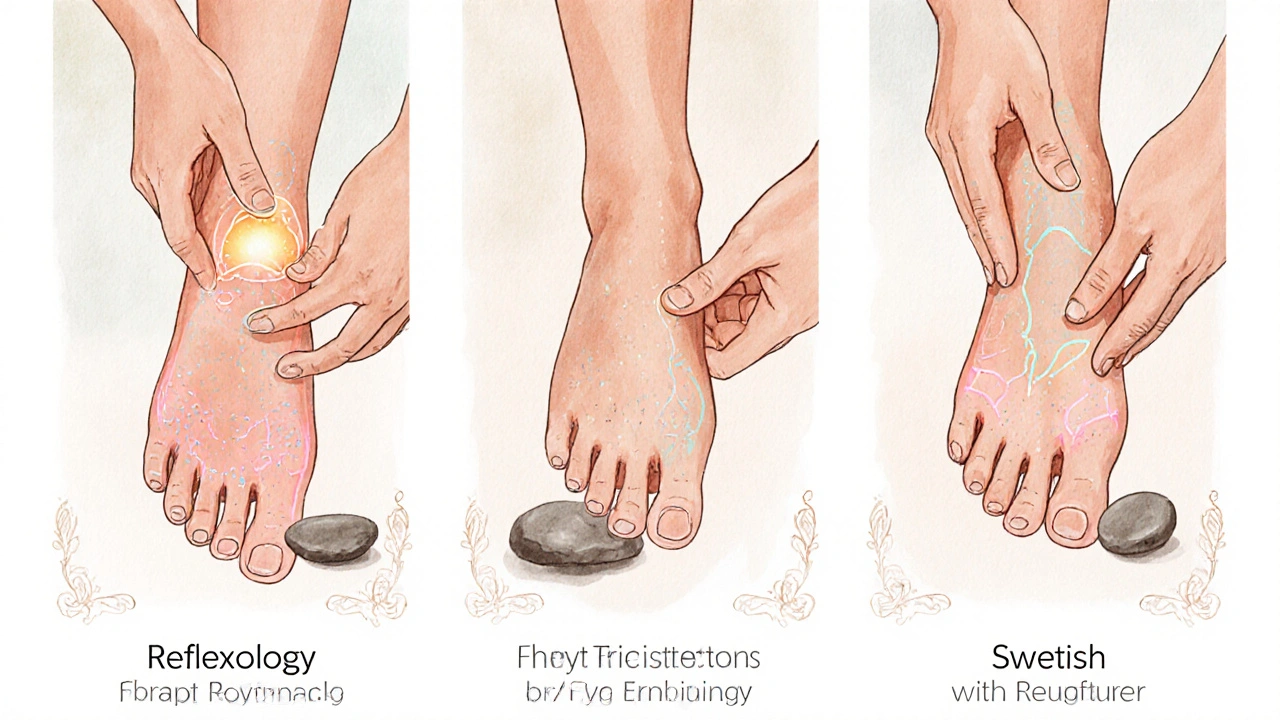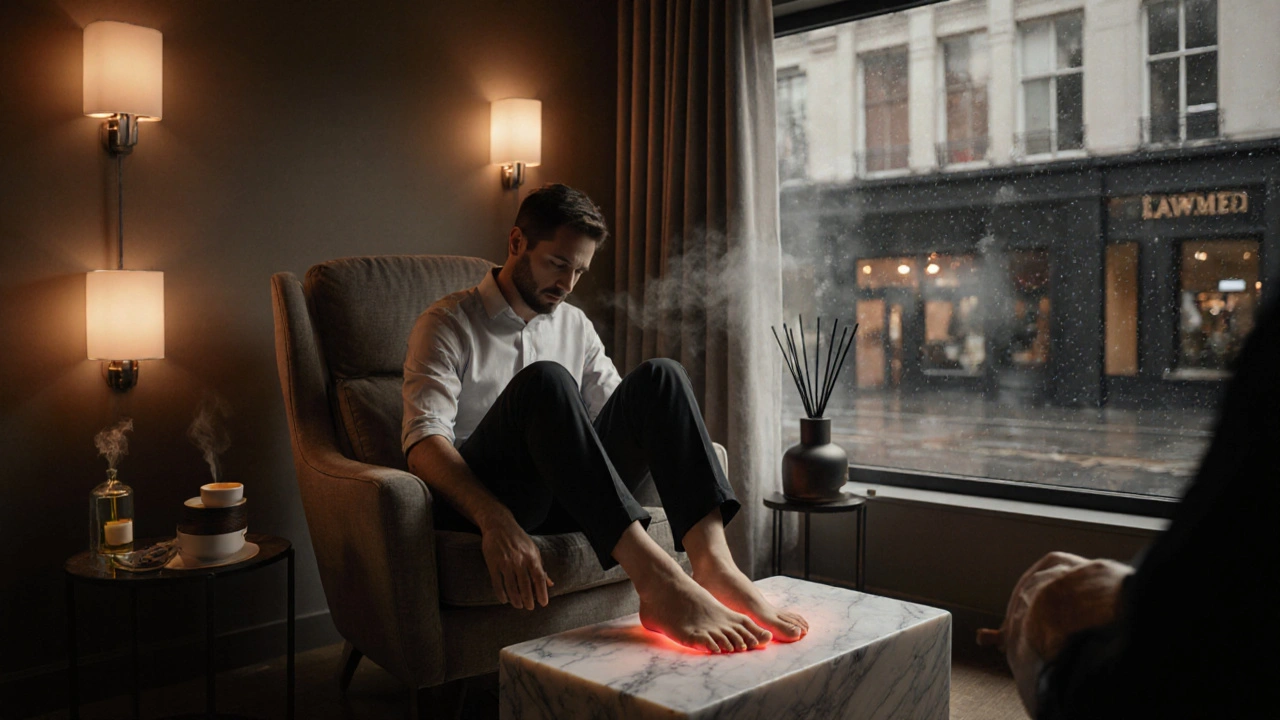Quick Takeaways
- Three core techniques - Reflexology, Thai, and Swedish - cover most relaxation needs.
- Typical sessions last 30‑60 minutes and cost £35‑£80.
- Combine warm oils and gentle stretching for the deepest calm.
- Pick a therapist with a certified foot‑massage credential for safety.
- Expect a noticeable drop in stress hormones after just one session.
When you’re on your feet all day, the idea of a foot massage is a lifeline. It’s not just a luxury - it’s a practical reset button that eases tight calves, soothes aching arches, and fires up the body’s natural chill‑out system. Below you’ll get the low‑down on the best techniques, how to score a session, price ranges, and what kind of vibe you’ll walk away with.
What Exactly Is a Foot Massage?
A foot massage is a hands‑on treatment that applies pressure, stretch, and sometimes heat to the muscles, tendons, and reflex points of the feet. The practice roots back to ancient Chinese medicine, but modern spas have mixed in Western styles like Swedish kneading and Thai foot work. The goal is simple: unblock tension, boost circulation, and trigger the nervous system’s “relaxation response.”
How to Get a Foot Massage in London
Finding a trustworthy therapist is easier than you think. Here’s a step‑by‑step cheat sheet:
- Search for a certified spa in your borough - look for "Registered Reflexologist" or "Level 3 Massage Therapist" on the website.
- Check reviews on Google or Trustpilot - a 4.5‑star rating plus real photos is a good sign.
- Book online; most places let you pick technique, length, and add‑ons (like aromatherapy).
- Arrive 5 minutes early, wear clean socks, and tell the therapist about any injuries.
- Relax, breathe deep, and enjoy the experience.
Most spas accept cash, contactless card, or Apple Pay. A quick call can confirm whether they have a “men‑only” slot if that makes you more comfortable.
Why Foot Massages Are So Popular
Three reasons keep the demand high:
- Stress‑busting power: A study by the University of Southampton (2023) showed a 23 % reduction in cortisol after a 45‑minute foot session.
- Convenient relief: Your feet carry the weight of the day - loosening them instantly improves posture and reduces lower‑back strain.
- Accessible luxury: You don’t need a full‑body session to feel pampered; a half‑hour foot massage costs a fraction of a full‑body hour.
Best Foot Massage Techniques and What They Offer
| Technique | Typical Duration | Pressure Style | Main Benefits | Approx. Cost (London) |
|---|---|---|---|---|
| Reflexology | 30‑45 min | Firm, point‑specific | Improves organ function, reduces anxiety | £45‑£65 |
| Thai Foot Massage | 45‑60 min | Stretch‑heavy, rhythmic | Boosts flexibility, releases deep muscle knots | £55‑£80 |
| Swedish Foot Massage | 30‑40 min | Gentle kneading, circular motions | General relaxation, improved circulation | £35‑£55 |
| Hot‑Stone Foot Massage | 45‑60 min | Warm stones + light pressure | Deep muscle warm‑up, pain relief | £70‑£90 |
| Acupressure | 30‑45 min | Targeted finger pressure | Balancing energy flow, headache relief | £40‑£60 |
Each method hits different nerve clusters, so pick the one that matches your goal. If you want a quick stress dump, Swedish works. For deeper body‑wide benefits, go reflexology or Thai.

What You’ll Feel After a Session
Most men report a three‑stage “after‑glow”:
- Immediate lightness: Your feet feel less heavy, and the first few minutes after the session bring a gentle tingling.
- Mid‑hour calm: Cortisol drops, heart‑rate steadies, and you might even nap without feeling groggy.
- Long‑term lift: Within 24‑48 hours, reduced swelling and better sleep quality show up, especially if you keep hydrated.
Combine the massage with a glass of water and a short walk, and the benefits stretch even further.
Tips to Maximise the Experience
- Stay hydrated: Drink at least 500 ml before and after - it helps flush out toxins.
- Prep your feet: Warm them in a soak of Epsom salts for 5 minutes; the therapist can work on relaxed skin.
- Ask for oil: Grapeseed or almond oil reduces friction and adds a subtle aromatherapy boost.
- Communicate pressure: If the therapist’s grip feels too hard, say “lighter, please.” It’s your body, you set the tone.
- Schedule regularly: A weekly 30‑minute foot massage keeps the nervous system in a constant chill‑mode.
Common Pitfalls and How to Avoid Them
Even seasoned foot‑massage fans slip up sometimes. Here are the usual mistakes and quick fixes:
| Mistake | Why It Hurts | Fix |
|---|---|---|
| Skipping the warm‑up | Cold muscles resist pressure | Do a 5‑minute warm foot soak |
| Choosing a cheap, unqualified therapist | Risk of strain or injury | Check credentials, read reviews |
| Stiff post‑massage posture | Blood pools, causing soreness | Walk slowly for 5 minutes after |
| Over‑pressing on sensitive points | Can trigger pain spikes | Communicate pressure levels throughout |
Bottom Line: Which Technique Wins?
If you’re after pure stress relief and a quick session, the Swedish foot massage wins on price and ease. For a holistic health boost that reaches organs and energy pathways, go with Reflexology. And if you love a bit of stretch and want to feel like a yoga master, the Thai style is the pick.
Whatever you choose, remember the core rule: a good therapist listens, adjusts pressure, and leaves you walking away lighter than you came in.

What is a foot massage?
A foot massage applies targeted pressure, stretch, and sometimes heat to the feet’s muscles, tendons and reflex points to relieve tension, improve circulation, and trigger the body’s natural relaxation response.
How do I book a foot massage in London?
Search for a certified spa, read reviews, choose a technique, and book online or by phone. Arrive a few minutes early, wear clean socks, and tell the therapist about any injuries.
Why are foot massages so popular?
They quickly lower stress hormones, relieve the weight‑bearing pressure on your feet, and offer an affordable way to feel pampered without a full‑body session.
Which foot massage technique is best for ultimate relaxation?
For pure relaxation at a reasonable price, Swedish foot massage is the top pick. If you want deeper health benefits, reflexology is the winner.
What feeling will I get after a session?
You’ll notice an immediate lightness in your feet, a calm that spreads through the body within an hour, and better sleep and reduced swelling over the next couple of days.






